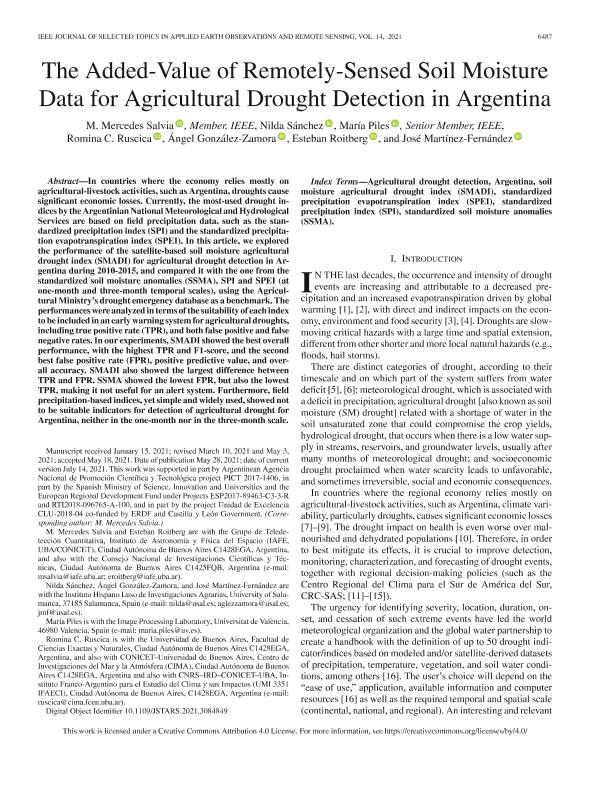Mostrar el registro sencillo del ítem
dc.contributor.author
Salvia, Maria Mercedes

dc.contributor.author
Sanchez, Nilda
dc.contributor.author
Piles, María
dc.contributor.author
Ruscica, Romina

dc.contributor.author
González Zamora, Ángel
dc.contributor.author
Roitberg, Esteban Gabriel

dc.contributor.author
Martinez Fernandez, Jose

dc.date.available
2022-07-28T19:22:07Z
dc.date.issued
2021-05
dc.identifier.citation
Salvia, Maria Mercedes; Sanchez, Nilda; Piles, María; Ruscica, Romina; González Zamora, Ángel; et al.; The added-value of remotely-sensed soil moisture data for agricultural drought detection in Argentina; Institute of Electrical and Electronics Engineers; IEEE Journal of Selected Topics in Applied Earth Observations and Remote Sensing; 14; 5-2021; 6487-6500
dc.identifier.issn
1939-1404
dc.identifier.uri
http://hdl.handle.net/11336/163464
dc.description.abstract
In countries where the economy relies mostly on agricultural-livestock activities, such as Argentina, droughts cause significant economic losses. Currently, the most-used drought indices by the Argentinian National Meteorological and Hydrological Services are based on field precipitation data, such as the standardized precipitation index (SPI) and the standardized precipitation evapotranspiration index (SPEI). In this article, we explored the performance of the satellite-based soil moisture agricultural drought index (SMADI) for agricultural drought detection in Argentina during 2010-2015, and compared it with the one from the standardized soil moisture anomalies (SSMA), SPI and SPEI (at one-month and three-month temporal scales), using the Agricultural Ministry's drought emergency database as a benchmark. The performances were analyzed in terms of the suitability of each index to be included in an early warning system for agricultural droughts, including true positive rate (TPR), and both false positive and false negative rates. In our experiments, SMADI showed the best overall performance, with the highest TPR and F1-score, and the second best false positive rate (FPR), positive predictive value, and overall accuracy. SMADI also showed the largest difference between TPR and FPR. SSMA showed the lowest FPR, but also the lowest TPR, making it not useful for an alert system. Furthermore, field precipitation-based indices, yet simple and widely used, showed not to be suitable indicators for detection of agricultural drought for Argentina, neither in the one-month nor in the three-month scale.
dc.format
application/pdf
dc.language.iso
eng
dc.publisher
Institute of Electrical and Electronics Engineers

dc.rights
info:eu-repo/semantics/openAccess
dc.rights.uri
https://creativecommons.org/licenses/by/2.5/ar/
dc.subject
AGRICULTURAL DROUGHT DETECTION
dc.subject
ARGENTINA
dc.subject
SOIL MOISTURE AGRICULTURAL DROUGHT INDEX (SMADI)
dc.subject
STANDARDIZED PRECIPITATION EVAPOTRANSPIRATION INDEX (SPEI)
dc.subject
STANDARDIZED PRECIPITATION INDEX (SPI)
dc.subject
STANDARDIZED SOIL MOISTURE ANOMALIES (SSMA)
dc.subject.classification
Geociencias multidisciplinaria

dc.subject.classification
Ciencias de la Tierra y relacionadas con el Medio Ambiente

dc.subject.classification
CIENCIAS NATURALES Y EXACTAS

dc.title
The added-value of remotely-sensed soil moisture data for agricultural drought detection in Argentina
dc.type
info:eu-repo/semantics/article
dc.type
info:ar-repo/semantics/artículo
dc.type
info:eu-repo/semantics/publishedVersion
dc.date.updated
2021-12-13T20:43:50Z
dc.journal.volume
14
dc.journal.pagination
6487-6500
dc.journal.pais
Estados Unidos

dc.journal.ciudad
Nueva Jersey
dc.description.fil
Fil: Salvia, Maria Mercedes. Consejo Nacional de Investigaciones Científicas y Técnicas. Oficina de Coordinación Administrativa Ciudad Universitaria. Instituto de Astronomía y Física del Espacio. - Universidad de Buenos Aires. Facultad de Ciencias Exactas y Naturales. Instituto de Astronomía y Física del Espacio; Argentina
dc.description.fil
Fil: Sanchez, Nilda. Universidad de Salamanca; España
dc.description.fil
Fil: Piles, María. Universidad de Valencia; España
dc.description.fil
Fil: Ruscica, Romina. Consejo Nacional de Investigaciones Científicas y Técnicas. Oficina de Coordinación Administrativa Ciudad Universitaria. Centro de Investigaciones del Mar y la Atmósfera. Universidad de Buenos Aires. Facultad de Ciencias Exactas y Naturales. Centro de Investigaciones del Mar y la Atmósfera; Argentina. Instituto Franco-Argentino sobre Estudios del Clima y sus Impactos; Argentina
dc.description.fil
Fil: González Zamora, Ángel. Universidad de Salamanca; España
dc.description.fil
Fil: Roitberg, Esteban Gabriel. Consejo Nacional de Investigaciónes Científicas y Técnicas. Oficina de Coordinación Administrativa Ciudad Universitaria. Instituto de Astronomía y Física del Espacio. - Universidad de Buenos Aires. Facultad de Ciencias Exactas y Naturales. Instituto de Astronomía y Física del Espacio; Argentina
dc.description.fil
Fil: Martinez Fernandez, Jose. Universidad de Salamanca; España
dc.journal.title
IEEE Journal of Selected Topics in Applied Earth Observations and Remote Sensing

dc.relation.alternativeid
info:eu-repo/semantics/altIdentifier/url/https://ieeexplore.ieee.org/document/9444130
dc.relation.alternativeid
info:eu-repo/semantics/altIdentifier/doi/http://dx.doi.org/10.1109/JSTARS.2021.3084849
Archivos asociados
